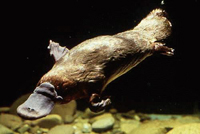The platypus has always impressed me as something kludged together from a box of spare parts and assembled by committee. It’s the weirdest creature you can imagine. It’s warm-blooded and has fur, but the females lay and incubate eggs—and then produce milk to feed their young, which are developmentally incomplete when they hatch. It has what looks for all the world like a duck’s beak, an electromagnetic sensing system, and (in the male) venomous spurs on the hind legs. It doesn’t have teeth (as an adult) or visible ears.
So, is it a mammal? A marsupial? Both? Neither? And how do you explain that beak?
A couple of months ago, a consortium of scientists from all over the world—the Australia (but of course) England, Germany, Israel, Japan, New Zealand (duh), Spain, and the US—announced that they had sequenced the platypus genome.
And it’s just as weird as you might expect. The platypus’s genes look like something ordered from an old-fashioned Chinese restaurant menu—one from Column A, two from Column B.
The conclusion to the paper in Nature, “Genome analysis of the platypus reveals unique signatures of evolution,” says, among other things, “Of particular interest are families of genes involved in biology that links monotremes to reptiles, such as egg-laying, vision and envenomation, as well as mammal-specific characters such as lactation, characters shared with marsupials such as antibacterial proteins, and platypus-specific characters such as venom delivery and underwater foraging.”
In other words, the platypus looks like what it is: a mammal with reptilian/avian and marsupial characteristics.
While this should not have been a surprise, somehow, it was—to me at least. When I read of the announcement in the news (the NIH press release), I went around grinning for days. A piece of the universe had just clicked into place and the world had become a little brighter and more fun.
The platypus is put together from a strange set of instructions. Knowing that makes me happy.
[Platypus photo by striatic, licensed under Creative Commons Attribution ShareAlike 2.0, and found on Wikimedia Commons.]










